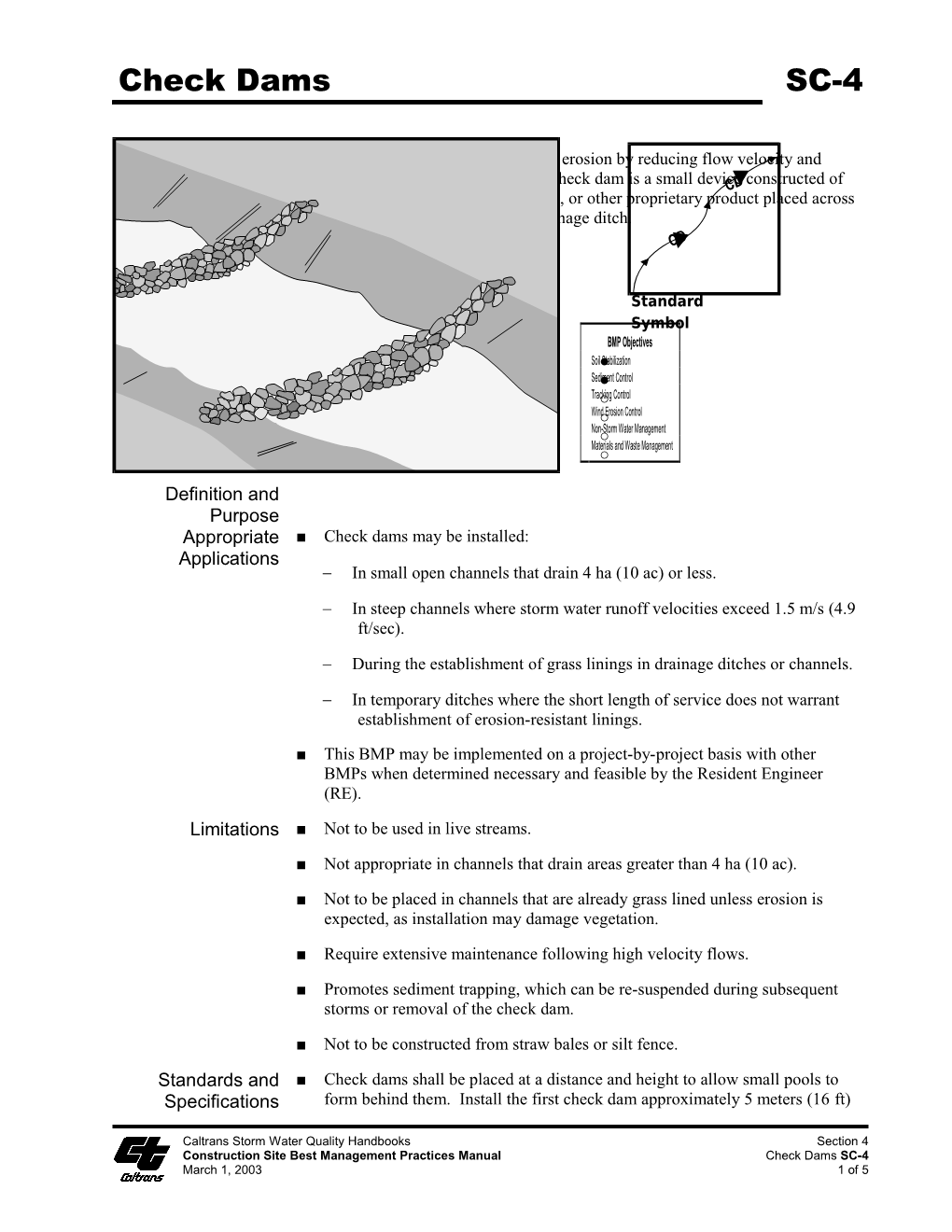Definition and
Purpose / Check dams reduce scour and channel erosion by reducing flow velocity and encouraging sediment settlement. A check dam is a small device constructed of rock, gravel bags, sandbags, fiber rolls, or reusableother proprietary product placed across a natural or man-made channel or drainage ditch. Check dams reduce scour and channel erosion by reducing flow velocity and encouraging sediment dropout Erosion of the drainage ditch is reduced by reducing the velocity of flow in the ditch.
Appropriate
Applications / ■Check dams may be installed:
In small open channels which that drain 4 ha (10 ac) or less.
In steep channels where storm water runoff velocities exceed 1.5 m/s (4.9 ft/sec).
During the establishment of grass linings in drainage ditches or channels.
In temporary ditches where a the short length of service does not warrant establishment of erosion-resistant linings.
■This BMP may be implemented on a project-by-project basis with other BMPs when determined necessary and feasible by the Resident Engineer (RE).This BMP may be implemented on a project-by-project basis with other BMPs when determined necessary and feasible by the Resident Engineer (RE).
Limitations / ■Not to be used in live streams.
■Not appropriate in channels that drain areas greater than 4 ha (10 ac).
■Not to be placed in channels that are already grass lined unless erosion is expected, as installation may damage vegetation.
■Require extensive maintenance following high velocity flows.
■Promotes sediment trapping, which can be re-suspended during subsequent storms or removal of the check dam.
■Not to be constructed from straw bales or silt fence.
Standards and
Specifications / ■Check dams shall be placed at a distance and height to allow small pools to form behind them. Install the first check dam approximately 5 meters (16ft) from the outfall device and at regular intervals based on slope gradient and soil type.
■For multiple check dam installation, backwater from downstream check dam shall reach the toe of the upstream dam.
■High flows (typically a 2-year storm or larger) shall safely flow over the check dam without an increase in upstream flooding or damage to the check dam.
■Where grass is used to line ditches, check dams shall be removed when grass has matured sufficiently to protect the ditch or swale.
■Rock shall be placed individually by hand or by mechanical methods (no dumping of rock) to achieve complete ditch or swale coverage.
■Fiber rolls may be used as check dams if approved by the RE or the Construction NPDES Coordinator. Refer to SC-5 “Fiber Rolls.”
■Gravel bags may be used as check dams with the following specifications:
Materials
Bag Material: Bags shall be either polypropylene, polyethylene or polyamide woven fabric, minimum unit weight 135 g/m2 (four ounces per square yard), mullen burst strength exceeding 2,070 kPa (300 psi) in conformance with the requirements in ASTM designation D3786, and ultraviolet stability exceeding 70% in conformance with the requirements in ASTM designation D4355.
Bag Size: Each gravel-filled bag shall have a length of 450 mm (18 in), width of 300 mm (12 in), thickness of 75 mm (3 in), and mass of approximately 15kg (33 lb). Bag dimensions are nominal, and may vary based on locally available materials. Alternative bag sizes shall be submitted to the RE for approval prior to deployment.
Fill Material: Fill material shall be between 10mm and 20mm (0.4 and 0.8 inch) in diameter, and shall be clean and free from clay balls, organic matter, and other deleterious materials. The opening of gravel-filled bags shall be secured such that gravel does not escape. Gravel-filled bags shall be between 13kg and 22kg (28 and 48 lb) in mass.one-half to one-inch Class 2 aggregate basean aggregate base, 10 mm to 20 mm in diameter, clean and free from clay, reclaimed asphalt concrete, and deleterious material, conforming to the provisions in Standard Specifications Section 26-1.02 “Class 2 Aggregate Base,.” of the Standard Specifications Fill material is subject to approval by the RE.
Fiber Roll: See SC-5.
Installation
Install along a level contour.
Tightly abut bags and stack gravel bags using a pyramid approach. Gravel bags shall not be stacked any higher than 1 meter (3.2 ft).
Upper rows of gravel bags shall overlap joints in lower rows.
Maintenance and
Inspection / ■Inspect check dams after each significant rainfall event. Repair damage as needed or as required by the RE.
■Remove sediment when depth reaches one-third of the check dam height.
■Remove accumulated sediment prior to permanent seeding or soil stabilization.
■Remove check dam and accumulated sediment when check dams are no longer needed or when required by the RE.
■Removed sediment shall be incorporated in the project at locations designated by the RE or disposed of outside the highway rightofway in conformance with the Standard Specifications.
Caltrans Storm Water Quality HandbooksSection 4
Construction Site Best Management Practices ManualCheck Dams SC-4
March 1, 20031 of 5
Check Dams / SC-4Caltrans Storm Water Quality HandbooksSection 4
Construction Site Best Management Practices ManualCheck Dams SC-4
March 1, 20031 of 5
Check Dams / SC-4Caltrans Storm Water Quality HandbooksSection 4
Construction Site Best Management Practices ManualCheck Dams SC-4
March 1, 20031 of 5
